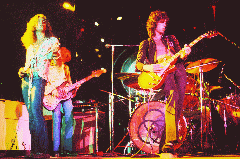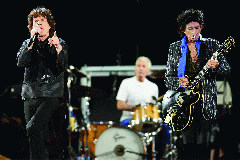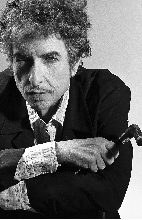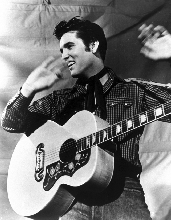The Evolution Of Music Part-VI
The Evolution Of Music Part-VI
Rock music
 Rock and roll developed out of country, blues, and R&B. Rock’s exact origins and early influences have been hotly debated, and are the subjects of much scholarship. Though squarely in the blues tradition, rock took elements from Afro-Caribbean and Latin musical techniques. Rock was an urban style, formed in the areas where diverse populations resulted in the mixtures of African American, Latin
Rock and roll developed out of country, blues, and R&B. Rock’s exact origins and early influences have been hotly debated, and are the subjects of much scholarship. Though squarely in the blues tradition, rock took elements from Afro-Caribbean and Latin musical techniques. Rock was an urban style, formed in the areas where diverse populations resulted in the mixtures of African American, Latin
and European genres ranging from the blues and country to polka and zydeco. Rock and roll first entered popular music through a style called rockabilly, which fused the nascent sound with elements of country music. Black-performed rock and roll had previously had limited mainstream success, but it was the white performer Elvis Presley who first appealed to mainstream audiences with a black style of music, becoming one of the best-selling musicians in history, and brought rock and roll to audiences across the world.
 The 1960s saw several important changes in popular music, especially rock. Many of these changes took place through the British Invasion where bands such as The Beatles, The Who, The Rolling Stones, and later Led Zeppelin became immensely popular and had a profound effect on American culture and music. These changes included the move from professionally composed songs to the singer-songwriter, and the understanding of popular music as an art, rather than a form of commerce or pure entertainment. These changes led to the rise of musical movements connected to political goals, such as civil rights and the opposition to the Vietnam War. Rock was at the forefront of this change. In the early 60s, rock spawned several subgenres, beginning with surf. Surf was an instrumental guitar genre characterized by a distorted sound, associated with the Southern California
The 1960s saw several important changes in popular music, especially rock. Many of these changes took place through the British Invasion where bands such as The Beatles, The Who, The Rolling Stones, and later Led Zeppelin became immensely popular and had a profound effect on American culture and music. These changes included the move from professionally composed songs to the singer-songwriter, and the understanding of popular music as an art, rather than a form of commerce or pure entertainment. These changes led to the rise of musical movements connected to political goals, such as civil rights and the opposition to the Vietnam War. Rock was at the forefront of this change. In the early 60s, rock spawned several subgenres, beginning with surf. Surf was an instrumental guitar genre characterized by a distorted sound, associated with the Southern California  surfing youth culture. Inspired by the lyrical focus of surf, The Beach Boys began recording in 1961 with an elaborate, pop-
surfing youth culture. Inspired by the lyrical focus of surf, The Beach Boys began recording in 1961 with an elaborate, pop-
friendly and harmonic sound. As their fame grew, The Beach Boys’ songwriter Brian Wilson experimented with new studio techniques and became associated with the counterculture. The counterculture was a movement that embraced political activism, and was closely connected to the hippie subculture. The hippies were associated with folk rock, country rock, and psychedelic rock. Folk and country rock were associated with the rise of politicized folk music, led by Pete Seeger and others, especially at the Greenwich Village music scene in New York. Folk rock entered the mainstream in the middle of the 1960s, when the singer-songwriter Bob Dylan began his career. He was followed by a number of country-rock bands and soft, folky singer-songwriters. Psychedelic rock was a hard-driving kind of guitar-based rock, closely associated with the city of San Francisco. Though Jefferson Airplane was the only local band to have a major national hit, the Grateful Dead, a country and bluegrass-flavored jam band, became an iconic part of the psychedelic counterculture, associated with hippies, LSD and other symbols of that era.
Following the turbulent political, social and musical changes of the 1960s and early 1970s, rock music  diversified. What was formerly a discrete genre known as rock and roll evolved into a catchall category called simply rock music, which came to include diverse styles like heavy metal and punk rock. During the ’70s most of these styles were evolving in the underground music scene, while mainstream audiences began the decade with a wave of singer-songwriters who drew on the deeply emotional and personal lyrics of 1960s folk rock. The same period saw the rise of bombastic arena rock bands, bluesy Southern rock groups and mellow soft rock stars. Beginning in the later 1970s, the rock singer and songwriter Bruce Springsteen became a major star, with anthemic songs and dense, inscrutable lyrics that celebrated the poor and working class.
diversified. What was formerly a discrete genre known as rock and roll evolved into a catchall category called simply rock music, which came to include diverse styles like heavy metal and punk rock. During the ’70s most of these styles were evolving in the underground music scene, while mainstream audiences began the decade with a wave of singer-songwriters who drew on the deeply emotional and personal lyrics of 1960s folk rock. The same period saw the rise of bombastic arena rock bands, bluesy Southern rock groups and mellow soft rock stars. Beginning in the later 1970s, the rock singer and songwriter Bruce Springsteen became a major star, with anthemic songs and dense, inscrutable lyrics that celebrated the poor and working class.
Thus, was rock music born and was to stay till date.



